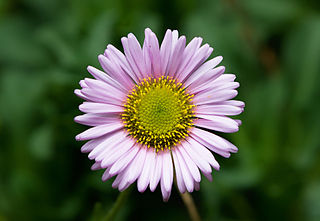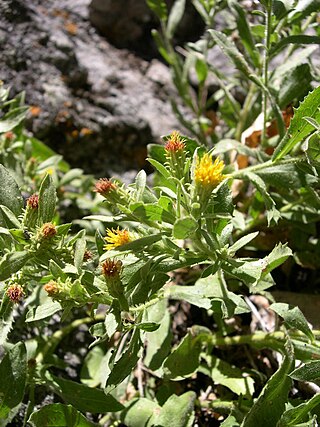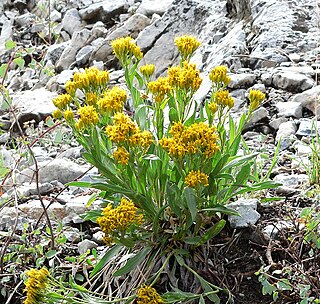
Astereae is a tribe of plants in the family Asteraceae that includes annuals, biennials, perennials, subshrubs, shrubs, and trees. They are found primarily in temperate regions of the world. Plants within the tribe are present nearly worldwide divided into over 250 genera and more than 3,100 species, making it the second-largest tribe in the family behind Senecioneae.

Ericameria nauseosa, commonly known as chamisa, rubber rabbitbrush, and gray rabbitbrush, is a shrub in the sunflower family (Aster) found in the arid regions of western North America.

Lorandersonia, commonly called rabbitbush, is a genus of North American flowering plants in the family Asteraceae.

Nestotus is a genus of flowering plants in the family Asteraceae.

Stenotus is a genus of flowering plants in the family Asteraceae. There are four species, all native to western North America. They are known commonly as mock goldenweeds.
Toiyabea is a genus of North American plants in the tribe Astereae within the family Asteraceae. The genus is named for the Toiyabe Mountains in the US state of Nevada.

Triniteurybia aberrans, the Idaho goldenweed, is a species of flowering plant in the tribe Astereae within the family Asteraceae. It is the only species in the genus Triniteurybia.

Xanthisma, common name sleepy-daisy, is a genus of flowering plants in the family Asteraceae.

Petradoria is a genus of North American subshrubs in the tribe Astereae within the family Asteraceae.
Eurybia horrida is a species of flowering plant in the family Asteraceae known by the common names spiny aster and horrid herrickia. It is native to Colorado and New Mexico in the United States, where it occurs only in the Canadian River basin. It most often included in genus Eurybia.
Toiyabea alpina, the alpine serpentweed, is a species of North American plants in the tribe Astereae within the family Asteraceae. It is native to the Toiyabe and Toquima Mountains of central Nevada.

Eurybia glauca is a North American species of flowering plants in the family Asteraceae, called the gray aster. It is native to the western United States, primarily in Arizona, New Mexico, Utah, Colorado, and Wyoming, with a few populations in Idaho and Montana.

Eurybia kingii is a North American species of flowering plants in the family Asteraceae, called the King's serpentweed or King's aster. It has been found only in the State of Utah in the western United States.
Eurybia wasatchensis is a North American species of flowering plants in the family Asteraceae, called the Wasatch aster. It has been found only in the state of Utah in the western United States.

Erythranthe, the monkey-flowers and musk-flowers, is a diverse plant genus with more than 120 members in the family Phrymaceae. Erythranthe was originally described as a separate genus, then generally regarded as a section within the genus Mimulus, and recently returned to generic rank. Mimulus sect. Diplacus was segregated from Mimulus as a separate genus at the same time. Mimulus remains as a small genus of eastern North America and the Southern Hemisphere. Molecular data show Erythranthe and Diplacus to be distinct evolutionary lines that are distinct from Mimulus as strictly defined, although this nomenclature is controversial.

Charles Lewis Anderson (1827-1910) was an American medical doctor who, in addition to the practice of medicine, made important contributions to fields of natural history, especially botany. Educated in Indiana, he spent most of his professional life in the upper Midwest and West. Many plants collected by him were subsequently named in his honor. He wrote about local natural history, and actively engaged in public service in places where he resided.












